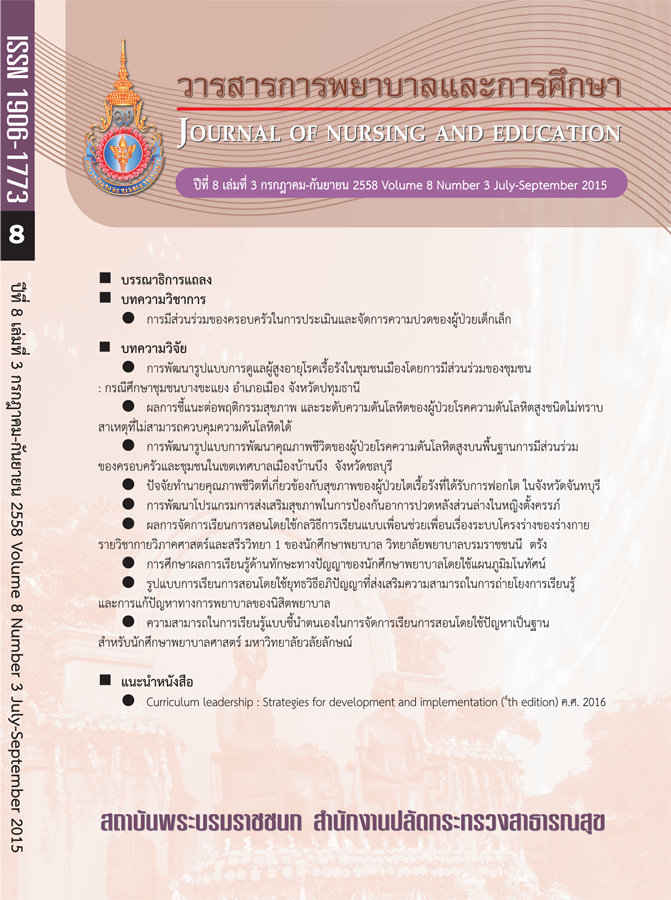ปัจจัยทำนายคุณภาพชีวิตที่เกี่ยวข้องกับสุขภาพ ของผู้ป่วยไตเรื้อรังที่ได้รับการฟอกไต ในจังหวัดจันทบุรี
คำสำคัญ:
Health-related quality of life, Dialysis patient, Hemodialysis, Continuous ambulatory peritoneal dialysisบทคัดย่อ
บทคัดย่อ
การวิจัยเชิงบรรยายครั้งนี้ มีวัตถุประสงค์เพื่อศึกษาคุณภาพชีวิตที่เกี่ยวข้องกับสุขภาพของผู้ป่วย
ไตเรื้อรังที่ได้รับการฟอกไต และศึกษาความสามารถของปัจจัยส่วนบุคคล ได้แก่ อายุ จำนวน
ปีการศึกษา การจ่ายค่ารักษา โรคร่วมเบาหวาน โรคร่วมความดันโลหิตสูง ระยะเวลาการฟอกไต ประวัติเข้ารับ
การรักษาในโรงพยาบาล ชนิดของการฟอกไต และปัจจัยทางคลินิกได้แก่ ระดับฮีมาโตคริต และระดับ
อัลบูมินในเลือด ในการร่วมกันทำนายคุณภาพชีวิตที่เกี่ยวข้องกับสุขภาพ กลุ่มตัวอย่างคือ ผู้ป่วยไตเรื้อรังที่ได้รับการฟอกไตที่โรงพยาบาลรัฐ 1 แห่ง โรงพยาบาลเอกชน 2 แห่ง และศูนย์ฟอกไต 1 แห่ง ในจังหวัดจันทบุรี จำนวน 244 ราย ซี่งเป็นผู้ป่วยฟอกเลือดด้วยเครื่องไตเทียมร้อยละ 76 และล้างไตทางช่องท้องต่อเนื่อง ร้อยละ 24 เก็บรวบรวมข้อมูลโดยใช้แบบสอบถามข้อมูลส่วนบุคคล และแบบประเมินคุณภาพชีวิตที่เกี่ยวข้องกับสุขภาพในคนไทยที่ได้รับการรักษาด้วยการฟอกไต วิเคราะห์ข้อมูลด้วยสถิติบรรยาย สถิติไคสแควร์ สถิติที และการวิเคราะห์ถดถอยพหุคูณแบบ Stepwise
ผลการวิจัยพบว่า ค่าเฉลี่ยคะแนนคุณภาพชีวิตที่เกี่ยวข้องกับสุขภาพโดยรวมของผู้ป่วยฟอกไต
อยู่ในระดับปานกลาง คุณภาพชีวิตโดยรวมของผู้ป่วยที่ได้รับการฟอกเลือดด้วยเครื่องไตเทียมและผู้ป่วยที่ล้างไตทางช่องท้องต่อเนื่องไม่แตกต่างกัน เมื่อเปรียบเทียบคุณภาพชีวิตรายด้าน พบว่าผู้ป่วยที่ล้างไตทางช่องท้องต่อเนื่องมีคุณภาพชีวิตในด้านเศรษฐกิจ สังคม และครอบครัว ดีกว่าผู้ป่วยที่ได้รับการฟอกเลือดด้วยเครื่องไตเทียม ส่วนผู้ป่วยที่ได้รับการฟอกเลือดด้วยเครื่องไตเทียมมีคุณภาพชีวิตในด้านการดำรงชีวิตอยู่กับอาการและอาการแสดงดีกว่าผู้ป่วยที่ล้างไตทางช่องท้องต่อเนื่องอย่างมีนัยสำคัญทางสถิติ และพบว่าระดับฮีมาโตคริต และประวัติเข้ารับการรักษาในโรงพยาบาล ร่วมกันทำนายคุณภาพชีวิตที่เกี่ยวข้องกับสุขภาพโดยรวมของผู้ป่วยฟอกไต (R2 = .062, p < .05)
ผลการวิจัยครั้งนี้เป็นข้อมูลที่นำไปใช้ในการปฏิบัติการพยาบาลเกี่ยวกับการประเมินและจัดการ
เกี่ยวกับภาวะซีด การให้ความสนใจในการเข้ารับการรักษาในโรงพยาบาล เพื่อส่งเสริมคุณภาพชีวิต
ที่เกี่ยวข้องกับสุขภาพในผู้ป่วยกลุ่มนี้
คำสำคัญ : คุณภาพชีวิตที่เกี่ยวข้องกับสุขภาพ ผู้ป่วยไตเรื้อรัง การฟอกเลือดด้วยเครื่องไตเทียม
การล้างไตทางช่องท้องต่อเนื่อง
Abstract
This descriptive research aimed to describe health-related quality of life (HRQOL) in chronic kidney disease patients receiving dialysis and to examine the predictive power of selected factors (i.e., age, education, medical payment, co-morbidity of diabetes, co-morbidity of hypertension, duration of receiving dialysis, history of hospitalization, type of dialysis, hematocrit level, and serum albumin level) on the HRQOL of dialysis patients. The sample consisted of 244 dialysis patients, 76% hemodialysis patients and 24% continuous ambulatory peritoneal dialysis patients, from one government hospital, two private hospitals and one private clinic in Chanthaburi Province. The instruments included the Personal Data Sheet and the Thai Health-Related Quality of Life Instrument for Dialysis Patients. The data were analyzed using descriptive statistics, chi-square test, t-test, and stepwise multiple regression analysis.
The results indicated that the mean score of overall HRQOL of the sample was at a moderate level. The mean scores of overall HRQOL between the hemodialysis
patients and the continuous ambulatory peritoneal dialysis patients were not significantly different. However, when considering each dimension of the HRQOL, mean scores of the Socioeconomic and Family Dimension of participants with CAPD were better than those in the hemodialysis group, but those of the Living with Symptom Dimension of participants with hemodialysis were better than those in the CAPD group. Additionally, the findings revealed that the hematocrit level and history of hospitalization mutually predict the overall HRQOL of dialysis patients (R2 = .062, p < .05).
The results of this study could be applied in nursing practice. In order to promote HRQOL of patients with dialysis, assessment and management of anemia and helping patients with history of hospitalization should be paid attention.
Keywords : Health-related quality of life Dialysis patient Hemodialysis Continuous
ambulatory peritoneal dialysis






